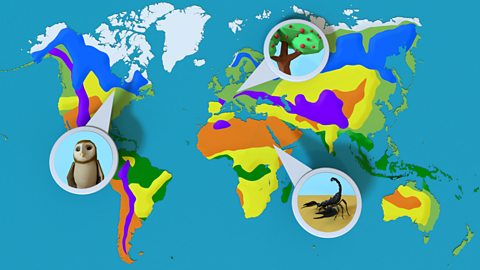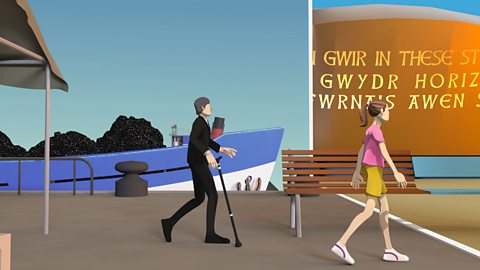What does diaspora mean?
A diaspora is a group of people who don’t live in their original country but still maintain their heritage in their new land.
The term comes from the Greek word for scatter, and it was first used to describe the dispersion of Jews during biblical times. The word is now used to describe scattered communities across the world that are the result of migration.
The USA is a prime example of a country which has many different diaspora communities such as African-Americans, Mexican-Americans and Irish-Americans.
Watch: Diaspora communities video
Watch this short clip to understand what is a diaspora community.
Since the beginning of time, humans have wandered the planet, moving culture, traditions, and entire communities from one place to another. There’s a name for this kind of scattered population, whose origins lie somewhere else. It’s called a diaspora. There are all sorts of examples. Think of Chinese communities, for example, in places like Manchester or London.
Historically, emerging cities like New York had many different diasporas, from different countries as well as faiths, each one inhabiting its own area of the city. Today, living in the Big Apple means engaging with a hodgepodge of cultural traditions provided by various diasporas. From the St Patrick’s Day parade to Jewish practices featured on TV shows like Friends. Traditions which come from all over the world, but are now, in their own way, as American as apple pie.
There is also a Welsh diaspora. Traditionally, there have been extremely strong links between Wales and several English cities. There is an area in Toxteth, Liverpool called the 'Welsh Streets' where you can find Pengwern Street, Rhiwlas Street and Wynnstay Street, named in honour of the Welsh immigrant workers who lived there during the 19th century and the birthplace of one Ringo Starr. He’s not actually Welsh. But we’ll take him.
The links between Wales and London continue to this day. Camden is home to the London Welsh Centre, where Welsh men and women away from home can get together, and pretend they never left the bright lights of Bethesda or Barry. There are Welsh churches and chapels, and even a Welsh-language primary school.
Then there’s the United States. Prominent Americans of Welsh descent include Miley Cyrus and Hillary Clinton and more presidents than you could shake a leek at. Some Welsh people emigrated for religious reasons, like the Quakers who moved to Pennsylvania in the late 17th century. Others moved to places like Ohio in search of work. Mainly farming and coal mining. Let it never be said that we’re set in our ways. Although Welsh-Americans represent only around 0.6 per cent of the US population, there’s no escaping the fact that we’ve made an impression. In more ways than one.
Around the same time Welsh people, many of them convicts, were leaving their mark on another new country: Australia. Literally. Meanwhile, in 1865, 153 Welsh pioneers set forth for a new land. One where they would be free to speak their own language and practice their own religion. Patagonia. Following an initial boom period, Welsh traditions were on the decline in Patagonia until tourists began showing up in droves in the 20th century, keen to see “little Wales beyond Wales” with their own eyes. Today, many in Patagonia are able to switch fluently between Welsh and Spanish.
It just goes to show that diaspora communities are never too far removed from their homeland. And that humans have really never been good at staying put.
History of diaspora
People migrate for different reasons. Some move for economic reasons to countries with better job opportunities and a higher standard of living. Others migrate to escape persecution or in search of greater freedom. Some migrants are forced to move by events such as wars and famines.
Examples of diaspora communities
Welsh communities in South America
The first 153 Welsh settlers arrived in Patagonia on 28 July 1865 on board a ship called Mimosa. They had sailed from Liverpool to Argentina to establish a Welsh-speaking colony called Y Wladfa away from the influence of other cultures.
More people followed them especially between 1880-87 and 1904-12. This was mainly because of depression in the Welsh coalfields.
The Welsh settled in the Chubut Valley and in the foothills of the Andes. There are towns and villages in Patagonia with Welsh names such as Trelew, Dolavon (DГґl Afon) and Trevelin (Tre Felin).
The community still survives today. There are 50,000 people with Welsh heritage in Patagonia, and it is thought that up to 5,000 of them speak Welsh.
Irish communities in the USA

The Irish diaspora in the USA is one of the largest in the country. According to the US Census Bureau 2010 study – those claiming Irish descent numbered over 34.7 million people. This makes it second only to those claiming German descent.
Irish people have moved away from Ireland for centuries but the Great Famine of the 1840s caused mass emigration. When the potato crop failed, one million people died and up to two million people emigrated in a little over ten years (1845-55). Most of them moved to North America and Great Britain.
Although most Irish Americans today are second and third generation, they still have a keen interest in their Irish heritage. Tourism Ireland estimates that nearly 2 million Americans visit the island of Ireland every year.
New York City holds the world’s largest St Patrick’s Day parade which draws about 2 million spectators to watch along the streets. The Chicago River is dyed green every year to celebrate Ireland’s patron saint.

Asian communities in the UK
Many cities within the UK are now home to diasporas of Asian origin from countries such as India, Pakistan and Bangladesh.
The UK has had a relationship with these south Asian countries since the 1600s. The British East India Company established trading settlements in India, and it later became part of the British Empire.
The 2011 Census found that people from Asian ethnic groups made up the second largest percentage of the population (7.5 per cent) in England and Wales.
Many Asian influences can be seen on culture in Britain. These include the popularity of Indian food, and films like East is East and Bend it like Beckham that explore south Asian integration into British life.
Impacts of diaspora communities
Diaspora communities can bring advantages to their new country and to the country where they’re from. These include:
- greater social and cultural diversity
- the transfer of skills and knowledge to their original country
- increased recognition for the country of origin
- increased trade between their new country and the country of origin

More on Identity
Find out more by working through a topic
- count2 of 3

- count3 of 3
